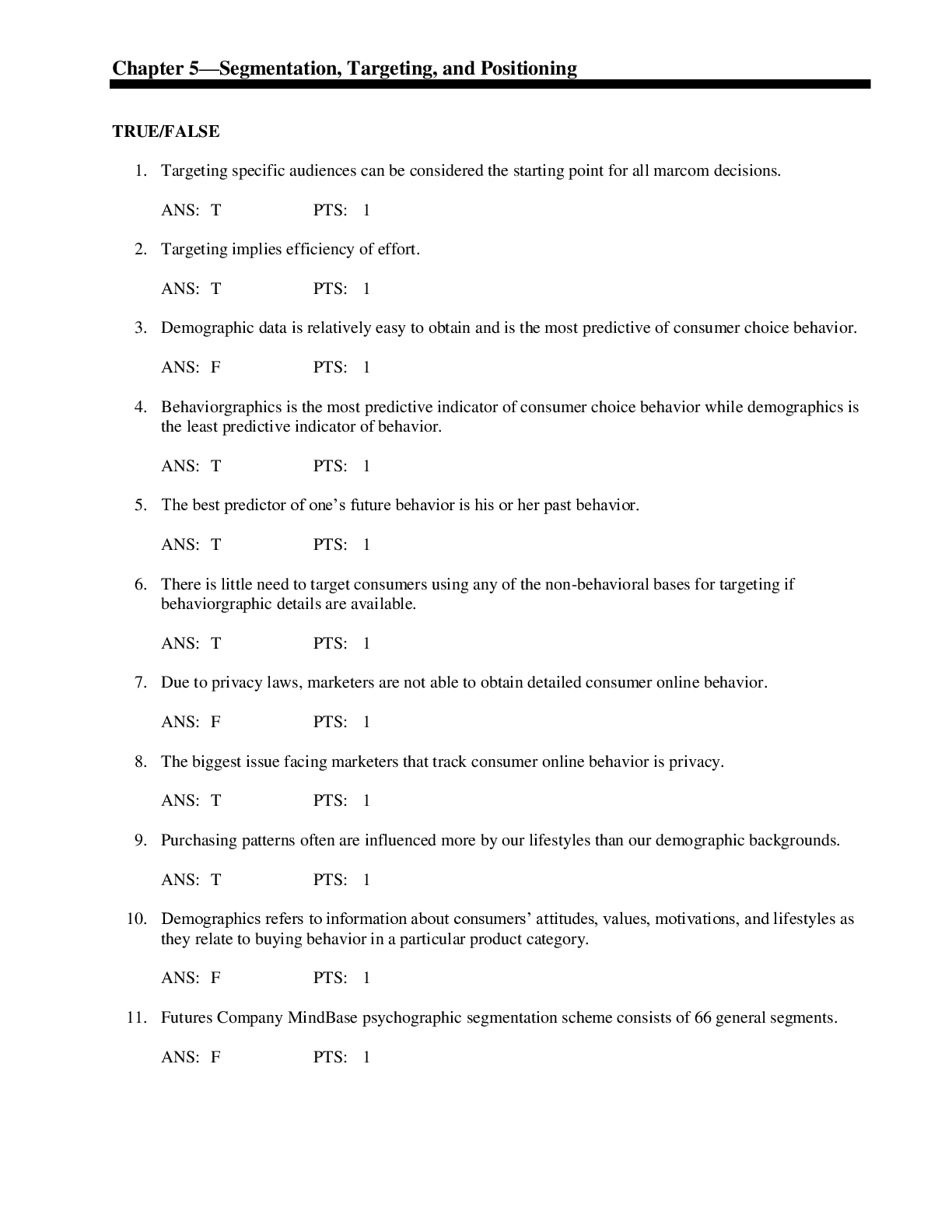History > QUESTIONS & ANSWERS > WGU C165 Integrated Physical Sciences Questions and Answers Already Passed (All)
WGU C165 Integrated Physical Sciences Questions and Answers Already Passed
Document Content and Description Below
WGU C165 Integrated Physical Sciences Questions and Answers Already Passed 4 eons Correct Answer- Hadean, Archean, Proterozoic, and Phanerozoic Acceleration Correct Answer- Term for any change in a... n object's speed and/or direction Air mass Correct Answer- Large body of air with the same temperature, humidity, and pressure amplitude Correct Answer- The distance between a wave's equilibrium and crest/trough in a transverse wave, or how compressed/expanded the medium becomes in a longitudinal wave asteroids Correct Answer- Very small, rocky bodies that orbit the sun Atom Correct Answer- The basic building block of matter atomic number Correct Answer- The number of protons in the nucleus of an atom balanced forces Correct Answer- Term for forces that combine to produce a net force of 0 Cenozoic era Correct Answer- Current era, the age of mammals chemical bonds Correct Answer- the attractive forces that hold atoms together chemical change Correct Answer- When matter changes in chemical composition Chemical Correct Answer- Any substance that has a definite, fixed compositionchemical potential energy Correct Answer- Energy that is stored in the chemical bonds in a substance chemical reaction Correct Answer- When chemical bonds are formed/broken in a chemical change chemical weathering Correct Answer- Weathering resulting from chemical processes Chemistry Correct Answer- The study of atoms and molecules, their structures, and their interactions to form substances coefficient Correct Answer- Number used to indicate the ratio of chemicals in a reaction, written before chemical formula cold front Correct Answer- A front where cold air moves in under a warm air mass. comets Correct Answer- Relatively small, icy, dusty bodies that travel around the sun in very elliptical orbits Compound Correct Answer- a chemical combination of two or more different elements in a fixed ratio compression Correct Answer- Region of longitudinal wave where particles are close together computer model Correct Answer- A detailed, complex model calculated by a computer conceptual model Correct Answer- A model used to visualize things that cannot be seen, such as atomscontinental to continental boundary Correct Answer- A convergent boundary between two continental plates with no subduction, causing tall mountain ranges with no volcanoes but large earthquakes control variable Correct Answer- The variable(s) you don't want to study, need to be either eliminated or kept constant convection cell Correct Answer- A circular pattern of rising warm air and sinking cool air Convection Correct Answer- The transfer of thermal energy by the circulation or movement of a liquid or gas convergent boundary Correct Answer- A tectonic plate boundary where the plates push into each other, causing large quakes covalent bond Correct Answer- Bond formed between atoms that share valence electrons crest Correct Answer- The highest point in a wave above equilibrium crust Correct Answer- Thin, outermost rocky shell at the surface of the earth dependent variable Correct Answer- The variable that changes because of an independent variable deposition Correct Answer- The process in which soil, sediment, or rocks are added to a landform Derived units Correct Answer- What is produced when the base units/quantities are combineddirect relationship Correct Answer- A relationship between two variables where increasing one increases the other, and vice versa divergent boundary Correct Answer- A tectonic plate boundary where the plates are separating, with volcanoes and few, weak quakes ductility Correct Answer- The ability to be stretched into wire Earth science Correct Answer- The study of the Earth's structure and composition, and processes that change Earth Elastic collision Correct Answer- A collision in which the total kinetic energy is conserved elastic potential energy Correct Answer- Energy stored in stretched springs, rubber bands, etc. elasticity Correct Answer- The amount of bounce an object has after a collision electromagnetic energy Correct Answer- Energy carried by electromagnetic waves. Light energy. electromagnetic waves Correct Answer- Waves with both an electric and magnetic component. Can only be transverse waves and can travel through a vaccuum Element Correct Answer- A pure substance made of only one kind of atom, defined by its proton count Energy Correct Answer- The capacity to do work or cause changeequilibrium Correct Answer- A position or state to which an oscillating object eventually returns to erosion Correct Answer- The mechanism responsible for the transportation or removal of material essential attributes of science Correct Answer- Studies the natural world Uses testable ideas Relies on data from observations/experiments Presented for evaluation by other scientists Leads to further questions/research Exosphere Correct Answer- The last layer of the atmosphere, beyond which exists a vacuum Exosphere Correct Answer- The outer layer of the atmosphere expansion Correct Answer- Region of longitudinal wave where particles are far apart (aka rarefaction) family Correct Answer- Name for elements in the same group of the periodic table that have the same number of valence electrons Fluid resistance Correct Answer- Friction when an object moves through a gas or liquid Force Correct Answer- Term for a push or a pull with direction [Show More]
Last updated: 2 years ago
Preview 1 out of 16 pages

Buy this document to get the full access instantly
Instant Download Access after purchase
Buy NowInstant download
We Accept:

Reviews( 0 )
$7.00
Can't find what you want? Try our AI powered Search
Document information
Connected school, study & course
About the document
Uploaded On
Sep 10, 2022
Number of pages
16
Written in
Seller

Reviews Received
Additional information
This document has been written for:
Uploaded
Sep 10, 2022
Downloads
0
Views
98
























